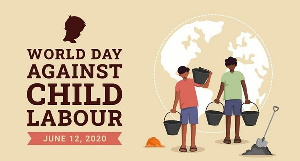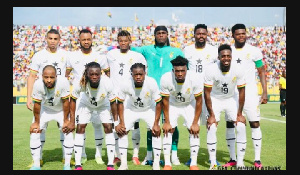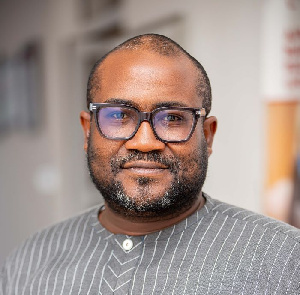- Home - News
- Polls
- Year In Review
- News Archive
- Crime & Punishment
- Politics
- Regional
- Editorial
- Health
- Ghanaians Abroad
- Tabloid
- Africa
- Religion
- Election 2020
- Coronavirus
- Photo Archives
- News Headlines
- Press Release
Press Releases of Friday, 11 June 2021
Source: CHRAJ
Commermoration of World Day Against Child Labour
The World Day Against Child Labour (WDACL) was established in 2002 by the International Labour Organization (ILO) to raise awareness and activism towards Child Labour prevention.
The ILO earmarked June 12 annually to commemorate the WDACL and to resound the realities of child labour that still remain persistent in the world.
The ILO was established in 1919 with social justice objectives including protection of children and young persons.
To achieve its child-interest oriented objects, the ILO adopted the Convention on Minimum Age (Convention No.138, 1973) providing for the minimum age of employment of children and followed by the adoption of (Convention No. 182, 1999) on the elimination of the worst forms of child labour.
Any work that deprives children of their childhood, their dignity, inhibits their potential and that is essentially harmful to their physical and mental development can be rightly classified as child labour!. The term “work” is not exhaustive in this definition. As a matter of fact, it involves work that is generally dangerous and harmful to children whether mentally, physically, socially or morally and/or interferes with their schooling by depriving them of education whether obliging them to leave school prematurely or requiring them to attempt to combine school attendance with excessively long and heavy work.
The conditions that may qualify as “work” and ultimately child labour are reliant on the child's age, the type and hours of work performed, the conditions under which it is performed and the objectives pursued by individual countries 2.
Article 3 of ILO Convention No. 182 defines the Worst Forms Of Child Labour (WFCL) to include all forms of slavery, sale and trafficking of children, and other forms of forced or compulsory labour, such as forced or compulsory recruitment of children for use in armed conflict, child prostitution, pornography and illicit activities - drugs, trafficking and work which are likely to harm the health, safety or morals of children.
The focus of this year's World Day Against Child Labour is unveiled under the theme: “Act Now: End Child Labour!” This is a firm call to action and a departure from mere commitments or the usual rhetoric. This theme aims at practical ways to end child labour and this requires participation of all stakeholders and individuals like never before.
The issue of child labour remains a huge global problem and though progress has been made over the past years it has been rather steadilyt; with COVID-19 pandemic posing a greater threat to stalling and reverting progress made.
It is estimated that 152 million children between ages 5 to 17 are in child labour, of this 64 million girls and 88 million boys — are in child labour globally, this accounts for almost one in 10 of all children worldwide.
Seventy-two million five hundred thousand (72.5 million) i.e. half of these children perform hazardous work that puts their health, safety or moral development at risk. In Africa, about half of the global statistics of child labour is prevalent (72 million children), followed by Asia and the Pacific (62 million).
Seventy percent of children in child labour work in agriculture, mainly in subsistence and commercial farming and herding livestock. A third of children in child labour lack education.
Ghana is a signatory to both of the ILO Convention No.138 (Minimum Age) and ILO Convention No.182 (Worst forms of child labour); and has accordingly ratified same. Nationally, there is extensive legal and regulatory framework that have been put in place to secure the rights of children from abuse. The 1992 Constitution which is the supreme law of the country guarantees the rights of children to education, health care as well as safeguards their dignity.
It seeks to protect the child from engaging in work that constitutes a threat to his health, education or development. The Children's Act 1996, Act 560 defines child labour as an exploitative work if it deprives the child of its health, education or development (section 87(b)).
In compliance with ILO Convention No. 138, the minimum age of a child in Ghana for purposes of employment is 15 years (section 89 of the Children's Act), whiles a child above 13 years may be engaged in light work i.e. work that does not harm the health and well-being of the child and does not impede his/her education.
Children are protected from hazardous labour such as mining, fishing or working in toxic environment. Only young persons above 18 years may be employed in hazardous work. The Criminal Offences Act 1960 (Act 29) criminalizes slavery as a second degree felony and prohibits sexual exploitation of children. The Human Trafficking Act, Act 694 criminalizes forced labour and child trafficking.
In addition to the legal regime prohibiting Child labour, Ghana has over the past years put in place some policy interventions to tackle child labour. Prominent among these is the National Plan of Action (NPAI) for the Elimination of the Worst Forms of Child Labour adopted in 2009 by the government.
The action plan which span from 2009 to 2015 has contributed to some success in the fight against child labor. In 2017 phase 2 of the NPA was introduced with the aim of addressing the gaps identified in the NPA1 and to solidify resolutions in achieving the United Nations Sustainable Development Goal (SDG) 8.7 (i.e. to “take immediate and effective measures to eradicate forced labour, end modern slavery and human trafficking and to secure the prohibition of the worst forms of child labour, including recruitment and use of children as soldiers, and by 2025 end child labour in all its forms”).
To this extent, measures were put in place to strengthen coordination, with the goal of reducing the worst forms of child labor to 10 percent by 2021. Areas of prime focus were cocoa, mining and fishing sectors.
Notwithstanding, the remarkable actions and efforts by the government to eliminate all forms of child labour in the country, one out of ten children in Ghana are still involved in the worst forms of child labour. Undoubtedly, the COVID-19 pandemic has greatly affected the rights of children globally. The emergence of this global pandemic with the associated closure of schools and lockdowns, provoked a decline in the progress made in the fight against child labour. Child labour increased as most families were affected financially.
In a survey conducted by Friends of the Nation (a civil society organisation in Ghana), children interviewed stated that they had to work during the pandemic mainly due to the hardships their families faced resulting from the crisis". These children were involved in hazardous work with some laboring in gold mining, fishing, carrying heavy loads for hours.
Some were exposed to highly toxic substances, breathing dust and fumes contributing to respiratory difficulties and headaches?. The sad realities of these children were that they had to risk their lives for a meager daily wage as low as GHc2.00 which could barely feed them and their families for a day.
These gruesome experiences pose a threat to their health and wellbeing. This is just a fraction of child labour reported during the pandemic.
Indeed, child labour can be eliminated absolutely, and this year's World Day Against Child Labour is a prompt reminder to us all, to aggressively work and engage collaboratively to end child labour now.
This call is firmly in support of Agenda 2030 as it envisions “A world which invests in its children and in which every child grows up free from violence and exploitation” as well as the determined goal to “end child labour in all its forms”.
We must tackle the root causes of child labour by implementing the objectives of the NPA until the last child in Ghana is freed from child labour.
To this end, the commission commits to supporting government in this journey by drawing attention of all stakeholders to some critical issues in this conundrum. Having in sight the four years ahead to achieve SDG 8.7 target set to end child labour by 2025, we encourage all other stakeholders to continue to create awareness of the trajectories of the WFCL and admonish the government to implement relevant recommendations of the Universal Periodic Review (UPR).
In particular, as we approach the Fourth Cycle Review which Ghana as a State Party is tentatively scheduled to submit its UPR Report to the Human Rights Council (HRC) in October 2022, the Commission advises government to take urgent steps to address specifically, recommendations 146.177, 146.179, 146.180, 146.181, 146.182, 146.183, 146.184, 146.185, 146.186, 146.190, and 146.192.
A summary of the said recommendations are to the effect that the government of Ghana accepted the obligation to implement measures that strengthen the protection of the rights of children and adolescents in order to eradicate child labour, strengthen efforts to implement the legal framework prohibiting child labour, provide adequate funding; investigate cases of the worst forms of child labour, bring alleged perpetrators to justice and ensure that all victims are adequately protected, assisted, rehabilitated and compensated; establish relevant mechanisms, procedures and guidelines to end child sexual exploitation and child labour; take the necessary measures to eliminate and penalize all forms of hazardous child labour; and improve the NAP on Child Labour and expand measures adopted in the area of mining to other sectors.











